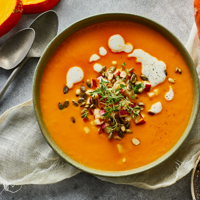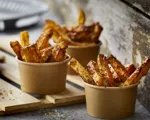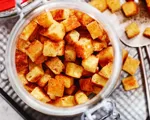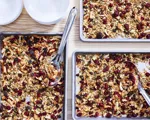
Spaghetti squash is one of the most intriguing winter vegetables available, famous for its pasta-like strands and versatility in everyday cooking. While it still captures the cosy autumnal feeling, you can easily work it into your weekday dinners. Whether you are discovering it for the first time or simply looking for new ways to enjoy it, this guide will walk you through everything you need to know. Find out how to cook spaghetti squash, when it is in season, and where it comes from, as well as storage tips and recipe inspiration.
What is spaghetti squash?
Spaghetti squash (Cucurbita pepo) is a winter squash with an oblong shape, hard outer skin, and pale-yellow flesh that turns into stringy, spaghetti-like strands when cooked. Depending on the variety and ripeness, the skin can range from creamy white to deep golden yellow, and the richer the colour, the riper it usually is.
What makes it especially popular during cooking is that, instead of breaking down into soft flesh like most squash, it separates into long, tender ribbons, making it a great alternative to pasta.
Spaghetti squash has a mild and slightly nutty flavour, with a tender yet slightly firm bite.
When is spaghetti squash in season?
Spaghetti squash is in peak season during the autumn months, typically from September through November. This is when it is harvested fresh and most widely available at farmers’ markets, produce stands, and supermarkets. The cooler weather of early autumn signals the perfect time to enjoy this golden-fleshed winter squash at its best.
Although autumn is the prime season, you can buy spaghetti squash year-round in many grocery stores thanks to its excellent shelf life. When stored properly, it keeps for months, so growers and shops can offer it well past harvest time.
Where did spaghetti squash come from?
Spaghetti squash comes from a mix of places. While all squash can be traced back to Central America, this one took a bit of a detour. It first showed up in Manchuria (northeast China) in the mid-1800s, likely bred from American squash varieties brought over centuries earlier.
By the 1920s, it had made its way to Japan, where growers developed improved strains. In 1936, the Burpee Seed Company introduced it to North America as “Vegetable Spaghetti,” and it quickly caught on during World War II as a pasta substitute.
Today, you will find it growing in North America, Asia, and parts of Europe.
How do you cook spaghetti squash?
You can cook spaghetti squash by roasting, steaming, or microwaving it until the flesh softens and can be shredded into strands. Below, we will go into more detail about the specific ways to cook it.
Roasting
Roasting brings out the squash’s natural sweetness and gives the strands a slightly caramelised flavour. To roast, cut the vegetable in half, either lengthwise for longer strands or crosswise for shorter ones, and scoop out the seeds. Brush the cut sides with olive oil, season with salt and pepper, and place cut-side down on a baking tray. Roast them at 190–200 °C for 30–50 minutes, depending on size.
Once the flesh is tender, use a fork to scrape it into strands. Serve with herbs, a drizzle of butter, or, as we do in
, with spicy tomato sauce and plenty of cheese.
Steaming or boiling
If you are short on oven space or want a quicker result, steaming or boiling works well too. Cut the squash in half or into large chunks, remove the seeds, and steam for 20–30 minutes or boil until you can easily pierce the flesh with a knife. Once cooked, drain thoroughly and use a fork to fluff the strands. This is excellent if you plan to mix the squash with sauces or include it in a bake or casserole.
Microwaving
Microwaving is the fastest way to cook spaghetti squash and requires very little effort. Pierce the whole squash several times with a knife to release steam, then microwave on high for 10–15 minutes, rotating halfway through. Once it has cooled slightly, cut it open, remove the seeds, and scrape the flesh into strands.
Air-frying
For those with an air fryer, spaghetti squash can be cooked quickly with a delicious roasted texture. First, cut the squash into halves or rings, depending on the size of your air fryer basket, scoop out the seeds, and brush the flesh with oil. Place cut-side down in the basket and air fry at 190 °C for 20–30 minutes and check occasionally for doneness. When soft, shred into strands and toss with your choice of seasonings or toppings.
Creative ways to use spaghetti squash
Spaghetti squash is a flexible ingredient that adapts beautifully to a variety of dishes. With its nutty flavour and soft texture, the vegetable happily plays along with whatever is on the menu. Here are some ideas to get you started:
As a pasta replacement with tomato, pesto, or creamy sauces
Baked with cheese and vegetables as a gratin or casserole
Tossed with garlic and herbs for a light side dish
Stir-fried in Asian-inspired dishes with soy or sesame sauce
Stuffed inside its own shell with roasted vegetables or meat
There are plenty more squash and pumpkin recipes waiting for you. Jump on over to our collection of:
and begin your new cooking adventure today.
How to roast the seeds
Autumn cooking is not complete without roasted seeds. They are nutty, crisp, and perfect for snacking or sprinkling over soups and salads.
Scoop the seeds out and rinse thoroughly under cold water to remove clinging pulp.
Pat them dry and toss with olive oil and spices, for example, paprika, garlic powder, or cinnamon.
Spread on a baking tray and roast at 150–165 °C for 20–30 minutes, stirring once or twice.
Cool and enjoy as a snack or salad topping, or store them in an airtight container at room temperature, where they will stay crisp for up to a month.
How to store spaghetti squash
Storing spaghetti squash correctly can extend its shelf life and preserve its flavour and texture, whether it is whole, cut, or cooked.
Storing it whole
Keep whole, uncut spaghetti squash somewhere cool, dry, and airy; around 10–13 °C is ideal. A pantry, cellar, or unheated room works well. Just keep it away from sunlight and damp spots, which can make it spoil faster. Do not refrigerate, as the cold and moisture can cause mould or make it go bad sooner.
Under the right conditions, a whole spaghetti squash can last anywhere from 2 to 4 months. Give it a check every now and then for soft spots or mould, and if you are storing a few, rotate them so they do not get bruised where they touch.
Storing it cut or cooked
Once spaghetti squash is cut, wrap any unused portions tightly in cling film or store them in a sealed, airtight container in the refrigerator. Use raw cut squash within 3–5 days. If you have cooked more than you need, the flesh can be portioned and frozen for up to 3 months. Let it cool completely before freezing, and store in airtight freezer bags or containers.
Why you should try other types of squash and pumpkin
Spaghetti squash is more than a trendy alternative to traditional pasta; it is a straightforward way into the wonderful world of squash and pumpkin.
If you are curious about other types of squash and pumpkin, why not explore butternut squash, red kuri squash, or Halloween pumpkin for autumn baking and carving?



&format=webp)




















&format=webp)
&format=webp)

















